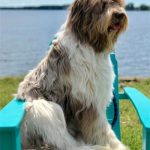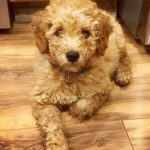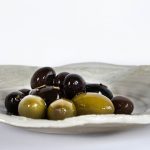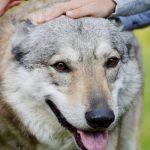Siberian Huskies come in many beautiful coat colors. But should you want one out of the traditional black and white or grey, go for the red Husky. It’s a stunning coat color that will amaze everyone that sees it. Read more about the red Huskies and the other details that make this breed one of the highly sought-after variations of Huskies.
Appearance
A red Husky sports a striking look. It’s actually one of the colors that will turn your head when seeing one. It is not rare but many people seek this color because it is hands down one of the most gorgeous coat colors you could ever find.
You will often find red Huskies in copper color and it’s also possible to see dogs with a beautiful blend of red and white. You can also find them in a gorgeous red and black combination. They have blue, brown, or multiple colored eyes.
The blue eye color is associated with the merle gene that is linked to a number of health problems in other purebred dogs. However, in the case of Siberian Huskies, having blue eyes is not a cause of concern because it is one of their normal eye colors given by their unique gene.
Multiple eye colors are also called split eye color. This happens when the eyes have different colors. One eye could be blue while the other one is close to brown. But did you know it is normal for Huskies to change their eye color? Your red Husky could have blue eyes as a pup and a different eye color as he gets older. This is normal just like the fact that Huskies tend to change their coat color.
The red Husky has two layers of coats, with the undercoat being soft and dense. It consists of fine strands that can help trap warm air. The outer layer is usually thick and long and has the important role of protecting your pet from the weather. The top layer is capable of blocking harmful rays and can also hold in heat when the weather is extremely cold.
Recognition
Red is among the recognized coat colors by the American Kennel Club and other major dog organizations. The first Huskies sporting a red coat are said to have originated in north Asia. The other acknowledged coat colors for Huskies are black, grey, sable, white, and the wild-looking agouti. Red itself comes in varieties of shades that are listed below for your reference.
Variations
In turn, red Huskies come in different shades. If you look at a picture gallery of these dogs, you will notice that the majority of them sport a copper coat, which is a reddish brown color. Still, you can find some with a pale red coating. Here are the shades of red you will find with Huskies:
- Copper – the most common of all red colors, copper is close to brown and is almost a deep shade of red. Dogs with this color have a solid red top coat. Underneath, it can be copper or brown. They usually have amber-colored eyes but it is also possible to see these dogs having blue eyes. They also usually have a white underbelly.
- Apricot – these dogs have a combination of white and red strands. The root is typically white while the tip is red, leaving a solid red appearance.
- Diluted red – as the name suggests, this is a light shade of red. Like copper-colored Huskies, dogs in diluted red coating either have amber or blue eyes and a liver-colored nose. You may also notice a light orange cast and a white underbelly in light red Huskies.
- Sable – the top coat of a sable dog consists of reddish colored roots that have black tips. The reddish hue is more evident in the saddle region. Their undercoat is usually red but can also be copper or chocolate. They either have a reddish brown or a black nose.
Grooming
Like any Husky, the red ones also have double layers of coat and go through a seasonal shedding at least once a year. They shed their entire coat to let new hair grow. In this case, avoid shaving or trimming your Husky’s coat. You only need to brush the coat more often to get rid of dead hair. Blowing of the coat normally occurs when the weather tends to be warm or during the spring or fall.
The fact that Huskies shed constantly also means they only require minimal bathing. This is because the dirt also falls off when they shed. It is important to groom the Husky regularly to prevent excessive shedding. After all, you wouldn’t want to see your floors and furniture bombarded with pet hair, right? The good news is you can always minimize shedding with a decent vacuum.
Besides, grooming can maintain the coat’s health. If not brushed on a regular basis, your pet’s skin would develop dander and oil that may cause irritation. Groom your pet daily and you will not have to worry about pet hair everywhere or your pet developing skin-related problems.
Personality
There are a number of studies linking a dog’s coat color to its personality. The truth is any animal will end up aggressive if trained badly. In general, Huskies are known for being active, playful, and free-spirited. They are always good-natured with people and even kids. It is one of the reasons why they are among the top choices as family pets.
However, they may not be recommended for first-time pet parents as they require lots of training and it matters that they get to burn off their excess energy on a daily basis. If you are ready for it, a Husky may be a good choice for you even if you are still a novice pet owner.
A red Husky is not just a beautiful variation of the breed. It will also impress you with its intelligent nature, especially if you are looking for a pet that can be easily trained. The red Husky can easily follow commands and enjoys lots of socialization.
What are Mini Red Huskies?
There is a miniature version of these dogs and they are as lovely as their larger counterpart. Breeders come up with miniature dogs by combining the standard breed with a much slower one or by introducing the achondroplastic or dwarfism gene.
The least supported way of developing miniature dogs is by breeding from runts or the smallest dog of a litter. While these dogs can grow as healthy as other dogs when properly nurtured, there are still a number of problems related to them, one of them being a compromised immune system.
When fully grown, they only weigh anywhere from 35-60 lbs. and stand not more than 24 inches tall. They are just companion sizes of the Siberian Huskies but they can also be very athletic like the standard breed. A mini Husky may be the perfect option for your family if you don’t have room for a bigger one in your home.
Red Husky Price
A red Husky from a reputable breeder may cost anywhere from $500 to $2000 per pup, depending on its pedigree. A pup from a championship show line is usually more expensive. If you don’t mind adopting a dog, you can save a lot more money because adoption fees are relatively lower than buying one. Never get a red Husky from puppy mills because they often do not adhere to the standard breeding practices of the breed.
Health
A red Husky is a fairly healthy breed that can live up to 12 years but just like any dog, it could have any condition common among its breed. The health concerns often associated with these dogs include:
- Bloating – this happens when the stomach becomes twisted because it’s filled with gas. Although Huskies are not always prone to bloating, this does not mean it is not one of your concerns. Any breed can suffer from this condition and while the exact cause is unknown, it helps to know the factors that trigger it, namely overfeeding and feeding immediately after exercise.
- Diarrhea – many Huskies are sensitive to certain food items and they also digest food slower than other breeds. Many Huskies suffer from inflammatory bowel disease (IBD). They are also lactose intolerant so it is best to avoid dairy products when you have a Husky. Diarrhea may occur if your pet accidentally consumed something out of his ordinary diet or if he is on medication.
- Thyroid problems – Huskies are among the breeds prone to hypothyroidism or a condition wherein their bodies are not capable of producing enough thyroid hormones. The usual symptoms of thyroid issues in canines include sudden increase in weight, loss of hair, and vulnerability to a number of skin problems.
- Zinc deficiency – one of the lesser known causes of sickness in Huskies is the malabsorption of zinc, which is often caused by a poor diet. This can often be seen in Huskies and Malamutes but it is not always easy to diagnose because the symptoms are so varied that it ends up being misdiagnosed. Zinc, next to iron, is the second most important trace minerals in dogs. They need it to work with other vitamins and minerals like calcium and B-complex for the body to work properly.
Every Husky owner needs to be aware of the common health problems associated with the breed. This way, the owner can work closely with his or her vet to create a preventive health plan and prevent further risks.
Tips in Buying a Red Husky
If you are eager to have a red Husky pup, work with a reliable breeder who will offer proof of pedigree and will give all the required vaccinations needed for the dog’s age. Your red Husky should already be given vaccines for Distemper, Hepatitis, Parainfluenza, and Parvovirus by the eighth week of age.
Good breeders will not end the relationship once your pup arrives at its new home and will always prioritize the pup’s health. Look for dog centers and organizations that will provide expert guidance throughout your journey as a pet owner. This can be very helpful if it’s your first time getting a Siberian Husky.
It is also important to ask the breeder if the red Husky’s parents were previously screened or are clear from any genetic problems associated with the breed. Genetic testing is relevant so the new pet parents are aware of any possible conditions the dog may inherit from its parents.
Breeders and rescue organizations already provide dogs with obedience training and leadership exercises before giving them to their new pet parents. Obedience training can encourage patience and positive behavior. A good breeder may suggest trainers to help you with your pet’s obedience training.
Many breeders already spay or neuter the dog before giving the dogs to their new owners. All Huskies, regardless of their color, benefit from neutering or spaying. They are not supposed to have puppies and they don’t have a “biological clock” to follow like humans. Not neutering dogs put them at risk for developing many types of cancer, like testicular cancer for males and mammary cancer in bitches.
Conclusion
Red Huskies are not rare but they are more sought-after due to their striking appearance. The red Husky, just like any Husky with any coat color is ideal for pet parents who don’t mind a pet that sheds constantly and is always up for adventures. It is generally friendly around kids, other people, and even other pets. If you think you can keep up with a breed that is always on the go, don’t wait too long and get your own red Husky fur baby!























